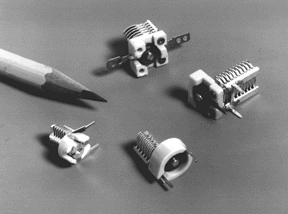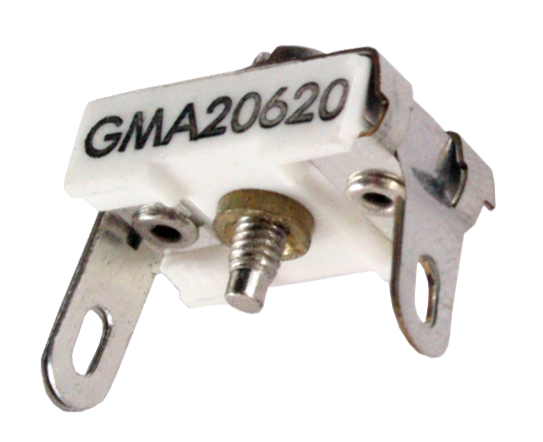Trimmer Capacitors

A trimmer capacitor is a type of variable capacitor (a capacitor that can have its capacitance manually adjusted by changing the positioning of the two conductive plates). A trimmer capacitor differs from a regular variable capacitor in that it’s smaller, and its value is set initially during production and is meant to be left there for some time until an adjustment is needed. It is meant to fine-tune the capacitance set by the larger capacitors in the circuit.
Trimmer capacitors have two main applications. When all fixed components are placed in a circuit, the resulting capacitance is often not precisely what was expected. If accuracy is vital, then the trimmer capacitors can be used to tweak the final capacitance value to the desired value. Along the same lines, as capacitors age they can lose capacitance. If this happens in a circuit, the trimmer capacitor can be adjusted to restore the desired capacitance to the circuit.

Trimmer capacitors are especially useful within circuits that need to be tuned to a precise frequency. Since they can make fine adjustments to the capacitance and frequency of a circuit, they can be used to calibrate. Thus, trimmer capacitors are often used in communications equipment, radio frequency equipment, and oscillators. Devices such as smart phones no longer use trimmer capacitors, as the shorter antennas over time have led to frequency too high for the trimmers to handle. These devices use a control system called a phase-locked loop instead.
When choosing a trimmer capacitor, one major factor to consider is the type of dielectric. The dielectric is the inductive material that goes between the conductive plates, allowing the capacitor to store charge. In a trimming capacitor, the type of dielectric can make a great difference in the performance of the circuit. If accuracy and precision is vital, then a Glass & Quartz or Sapphire dielectric provides the best tuning sensitivity, stability, and efficiency. On the other hand, while a ceramic capacitor is not as stable or precise, it is cheaper and may work just as well for your circuit. The following table shows the various factors that should be taken into mind when selecting a trimmer capacitor, and shows how each of the dielectrics perform.
Dielectric Properties
| Multiturn | Single Turn | ||||||||
| Relative Performance (1=Best) | Glass & Quartz | Sapphire | Plastic | Ceramic | Air | Ceramic | Plastic | Air |
Mica Compression |
| Stability | 1 | 1, 2 | 2 | 3 | 1 | 3 | 2 | 1 | 3 |
| High Q | 1 | 1 | 1 | 2 | 1 | 3 | 1, 2 | 1 | 1 |
| Tuning Adjustment Sensitivity | 1 | 1 | 2 | 2 | 1 | 3 | 3 | 3 | 3 |
| High Working Voltage | 1 | 1, 2 | 1, 2 | 1 | 3 | 3 | 3 | 3 | 2 |
| Operation UHF & Up | 3 | 1 | 3 | 2, 3 | 1, 2 | 1, 3 | 2 | 1 | 3 |
| RF Current Handling Capability | 2 | 2 | 3 | 3 | 1 | 3 | 2 | 1 | 1 |
| Physical Size | 3 | 1 | 3 | 2, 3 | 3 | 1 | 1, 2 | 3 | 3 |
| Temperature Range | 1 | 1 | 2 | 2 | 1 | 1, 2 | 2 | 1 | 2 |
| Shock and Vibration Resistance | 1 | 1 | 2 | 2 | 1 | 2 | 2 | 1, 2 | 3 |
| Moisture Resistance | 1 | 1, 2 | 1 | 3 | 1 | 3 | 1 | 1 | 2 |
| Price | 3 | 3 | 2 | 1 | 3 | 1 | 1 | 2 | 1 |
| Relative Performance (1=Best) | Glass & Quartz | Sapphire | Plastic | Ceramic | Air | Ceramic | Plastic | Air |
Mica Compression |
| Multiturn | Single Turn | ||||||||
Glossary of Terms:
Multiturn vs Single Turn: This refers to how much you must turn the adjustment screw to reach all possible capacitance of the trimmer. Single turn allows you to adjust the trimmer very quickly, but is not as accurate as multiturn, where you can make finer and more accurate adjustments.
Stability: Stability is the measurement of how well the capacitance stays constant over time, when subjected to external pressures such as temperature.
Q: Q (quality factor) measures the efficiency of a capacitor. It is the ratio of a capacitor’s reactance to its resistance (or energy stored to energy dissipated) at a given frequency. A capacitor with a very high Q does not lose much energy.
Tuning Adjustment Sensitivity: This is the measurement of how responsive the trimmer capacitor is to tuning, and how fine an adjustment can be made. A multi-turn capacitor will be strongest in this area, as it gives much more control.
High Working Voltage: Working voltage is the voltage level that a capacitor can withstand continuously and still perform as intended.
Operation UHF & Up: UHF stands for Ultra-High Frequency. Trimmer capacitors often lose Q at higher frequency, but some dielectrics are much more resistant to this effect than others.
RF Current Handling Capability: RF stands for radio frequency. Not all trimmers are able to handle exposure to this as well as others. Radio Frequency current can lead to a temperature increase in a capacitor, which in turn can lead to a loss in Q.
Physical Size: Refers to the actual measurements of the capacitor. In certain cases a smaller capacitor may be desired if it needs to fit into a tight space.
Temperature Range: This refers to the range of temperatures in which the capacitor can be used and perform safely. If the capacitor is at a temperature outside of this range its life may decrease dramatically, and it could fail.
Shock and Vibration Resistance: Shock and vibration is another one of the many external effects that can alter the capacitance.
Moisture Resistance: Capacitors can be vulnerable to humidity and moisture, as moisture that gets through the casing of the capacitor can alter the resistance of the dielectric.
Price: In addition to the above factors, price is always an issue as well. It is advisable to evaluate your application and need, and then balance what performance level a dielectric can achieve with how much each dielectric will cost.

